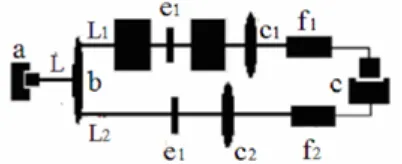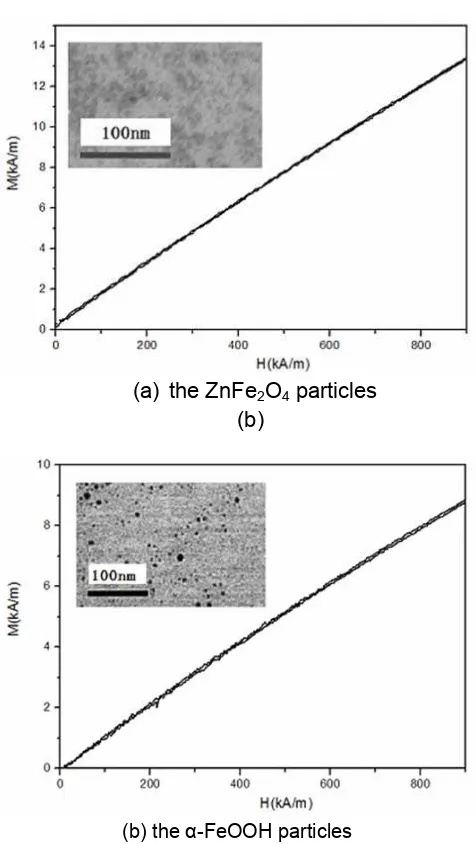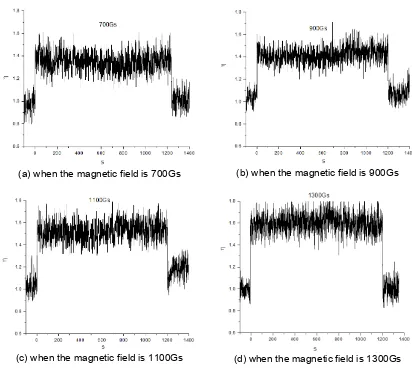DOI: 10.12928/TELKOMNIKA.v14i3A.4438 306
The Field-Induced Effect of Light Transmission for
FeOOH-ZnFe2O4 Ferrofluids Control
Anrong Wang*1, Pengzhi Wei2, Yufeng Shao3, Xiangfei Nie4, Kezhong Liang5, Haiyan Huang6
1,3,4,5,6
Key Laboratory of Signal and Information Processing, Chongqing Three Gorges University, Wanzhou District, Chongqing, 404100, P. R. China
2
College of Science, Harbin Engineering University, Nangang District, Harbin, 150006, P. R. China *Corresponding author, e-mail: [email protected]
Abstract
The paper is supposed to find the change of the light transmission rate with the change of time of the same volume fraction of ZnFe2O4 ferrofluids, FeOOH ferrofluids and FeOOH-ZnFe2O4 binary ferrofluids, applied in different magnetic field, in parallel to the light direction. The field-induced effects of light transmission for the three ferrofluids are compared, so as to explore the reason from the microstructure change of the ferrofluids.
Keywords: Ferrofluids, magnetic field, light transmission, field-induced effect
Copyright © 2016 Universitas Ahmad Dahlan. All rights reserved.
1. Introduction
Ferrofluids refer to the colloidal suspensions dispersed of the strong magnetic nanoparticles in certain carried liquid. Applied in the magnetic field, magnetic particles form a chain, orderly arrange along the direction of the magnetic field, creating optical anisotropy. Researches have been carried out on light transmission change and resilience of magnetic nanoparticles under the effect of the magnetic field [1-3]. Based on that [4], the paper is to make a comparison of the field-induced effect of light transmission for weak magnetic ZnFe2O4 ferrofluids, FeOOH ferrofluids and FeOOH-ZnFe2O4 binary ferrofluids, as well as to present the rule and mechanism of the field-deduced light transmission.
2. Materials and Methods
2.1. The Preparation of Samples
The ZnFe2O4 and α-FeOOH nanoparticles are produced by chemical co-precipitation technology with FeCl3, ZnCl2, NaOH, HCl, and HNO3. Then Q = 0.04, v=0.4% FeOOH of ionic ferrofluid and Q = 0.04, v=0.4% ionic ferrofluid are synthesized, in the end, FeOOH mixed with magnetic liquid ZnFe2O4 as FeOOH-ZnFe2O4 dual magnetic liquid. The FeOOH-ZnFe2O4 binary ferrofluids are obtained by mixing both the ferrofluids.
The samples are ZnFe2O4 ferrofluids, FeOOH ferrofluids and FeOOH-ZnFe2O4 binary ferrofluids, in the flat glass case, made into (15mm×15mm×0.53mm) film-like light transmission samples.
2.2. Experimental Apparatus Figure of Field-Deduced Light Transmission
Figure 1. The sketch map of experimental device
3. Results
3.1. The TEM and VSM Measure of ZnFe2O4 and α-FeOOH Nanoparticles
Figure Figure 2(a) and Figure 2(b) are the TEM and VSM test chart of ZnFe2O4 and α -FeOOH nanoparticles. From the figure both are ball-shaped. Size distribution of the nanoparticles, produced by chemical co-precipitation technology, is lognormal distributed.
Where x the diameter of the nanoparticles, xg is the geometric average particle size,
g
is the geometric standard deviation of size distribution. So 4.22nm and 8.16nm are the geometric average particle sizes of ZnFe2O4 nanoparticles and α-FeOOH nanoparticles, 0.26 is the geometric deviations.
As ZnFe2O4 is weak magnetic, its magnetization curve is linear, the initial susceptibility T
1 , coupling constant between particles,
m d kBT
3.2. Field-Deduced Effect of Light Transmission for Sample ZnFe2O4 Ferrofluids
(a) the ZnFe2O4 particles (b)
(b) the α-FeOOH particles
(a) when the magnetic field is 700Gs (b) when the magnetic field is 900Gs
(c) when the magnetic field is 1100Gs (d) when the magnetic field is 1300Gs
Figure 4. Field-deduced effect of light transmission for sample FeOOH ferrofluid
From the experiment, the moment the magnetic field is coupled to the sample FeOOH ferrofluids, the rates of light transmission increases greatly before it remain stable. When the magnetic field is removed, the light transmission returns to 1 quickly.
3.4. Field-Deduced Effect of Light Transmission for Sample FeOOH-ZnFe2O4 Ferrofluids Sample FeOOH-ZnFe2O4 ferrofluids is placed in the experiment device. It’s 30s after transmitted light becomes stable, respectively, 700Gs, 900Gs, 1100Gs and 1300Gs of magnetic field is coupled. The magnetic field is removed after the 1200s. The intensity of transmitted light is observed over time, as shown in Figure 5.
(a) when the magnetic field is 700Gs (b) when the magnetic field is 900Gs
(c) when the magnetic field is 1100Gs (d) when the magnetic field is 1300Gs
Figure 5. Field-deduced effect of light transmission for sample FeOOH-ZnFe2O4 Ferrofluids
4. Discussions
4.1. Analysis of Field-Deduced Effect of Light Transmission for Sample ZnFe2O4 Ferrofluid
From Figure 3, it can be deduced that nanoparticles in ZnFe2O4 ferrofluid don’t form aggregate, under the effect of static magnetic, applied external magnetic field. That is because inherent magnetic moment of ZnFe2O4 ferrofluid, is smaller than 1[7, 8], which tends to the magnetic field but can’t form aggregate or change the intensity of light transmission. External magnetic field removed, ZnFe2O4 ferrofluid restores to the original state in Brownian motion and Neil rotating.
4.2. Analysis of Field-Deduced Effect of Light Transmission for Sample FeOOH Ferrofluids
coupling constant of α-FeOOH nanoparticles and ZnFe2O4 nanoparticles is calculated as
3
10 09 .
3 . Magnetic interaction between nanoparticles in α-FeOOH and ZnFe2O4 can’t form aggregate so as to cause magneto-optical effect. The similarity of the effects proves the field-deduced effect of light transmission for sample FeOOH-ZnFe2O4 Ferrofluids is caused by α -FeOOH nanoparticles’ optical anisotropy. Ellipsoid orientation order changes optical characteristic from the isotropic to anisotropic, which leads to the field-deduced light transmission. External magnetic field is applied, the nanoparticles is ferromagnetic or ferrous single domain nanoparticles of 10nmor so. Its interaction potential with the magnetic can be described as:
H m
UmH (2)
Of which is the permeability. From the equation, under the influence the magnetic field, magnetic moment of the particles tends to the field direction. If α-FeOOH nanoparticles were rigid particles, the rotation of the magnetic moment would bring the rotation of the whole particles. As α-FeOOH is orthogonal crystal structure, whose dielectric constant is anisotropy, the rotation of the magnetic moment causes the change of dielectric constant, which leads to the change of the intensity of the light transmission. The rate of permeability can be referred as:
r ferrofluids can be regarded as the background of FeOOH nanoparticles [1], which decreases the effective relative permeability. The particles are more likely to tend to the field direction, which makes the field-deduced dielectric properties change more obvious, and change of the light transmission intensity more impressive.
5. Conclusions
Experiment of field-deduced effect of light transmission for sample ZnFe2O4 ferrofluids shows nanoparticles is weak magnetic. Nanoparticles can’t form aggregate, they tend to be magnetic field directed. Nanoparticles are of the cubic lattice system and isotropic, wouldn’t cause the change of intensity of light. External magnetic field removed, ZnFe2O4 ferrofluids restores to the original state in Brownian motion and Neil rotating [13, 14].
Experiment of field-deduced effect of light transmission for sample FeOOH ferrofluid shows nanoparticles is weak magnetic. When external magnetic field is applied, magnetic interaction between nanoparticles can’t form aggregate. α-FeOOH nanoparticles are in magnetic dielectric ellipsoid system of the cubic crystal system. External magnetic field applied, ellipsoid orientation order changes optical characteristic from the isotropic to anisotropic, which leads to the field-deduced light transmission. External magnetic field removed, FeOOH dielectric ellipsoid restores to the balance in Brownian motion and Neil rotating.
field-deduced effect of light transmission for sample FeOOH-ZnFe2O4 ferrofluids is caused by α -FeOOH nanoparticles’ optical anisotropy. Ellipsoid orientation order changes optical characteristic from the isotropic to anisotropic, which leads to the field-deduced microstructure change and improve the macro field-deduced light transmission of FeOOH ferrofluid. So FeOOH-ZnFe2O4 binary ferrofluids has a better magnetic response than FeOOH ferrofluids.
Acknowledgements
Financial support for this work was provided by the National Natural Science Foundation of China (No.61107064), the Chongqing University Innovation Team Founding, China (No.KJTD201320), the Frontier and Applied Basic Research Project of Chongqing, China (No.cstc2014jcyjA1302 and No.cstc2016jcyjA1233), the Science Technology Special Funds in Wanzhou District, and the Chongqing Graduate Scientific Research Innovation Project (No.CYS15225).
References
[1] CY Hong. Field-induced structural anisotropy in magnetic fluids. Journal of Applied Physics. 1999; 85(8): 5962-5864.
[2] SY Yang, YP Chiu, BY Jeang. Origin of field-dependent optical transmission of magnetic fluid films. Applied Physics Letters. 2001; 79: 2372-2374.
[3] J Li, XD Lin, YQ Lin. Relaxation behavior measuring of transmitted light through ferrofluids film. Applied Physics B. 2006; 82(1): 81-84.
[4] Li G, Zhao X, Wen D, Yu Y. Research on Electromagnetic Excitation Resonant Sensor Based on Microelectromechanical System. TELKOMNIKA (Telecommunication Computing Electronics and Control. 2015; 13(4): 1121-1126.
[5] W Reed, JH Fendler. Anisotropic aggregates as the origin of magnetically induced dichroism in ferrofluids. Journal of Applied Physics. 1986; 59(8): 2914-2924.
[6] BH Erne′, K Butter, BWM Kuipers, GJ Vroege. Rotational Diffusion in Iron Ferrofluids. Langmuir. 2003; 19(20): 8218-8225.
[7] Mingdan L, Jun CA, Yong W, Pengfei T, Sifen Z. Research on the Pulsed Magnetic Field Device for Sterilization of Fruit and Vegetable Equipment. TELKOMNIKA Indonesian Journal of Electrical Engineering. 2013; 11(4): 2084-2087.
[8] AF Psheichnikor, VV Mekhonoshin. Equilibrium magnetization and microstructure of the system of superparamagnetic interacting particles: numerical simulation. Journal of Magnetism and Magnetic Materials. 2000; 213: 357-369.
[9] B Huke, M Lücke. Magnetic properties of colloidal suspensions of interacting magnetic particles. Reports on Progress in Physics. 2004; 67(10): 1731-1768.
[10] J Li, AR Wang, YQ Lin, XD Liu, J Fu, LH Lin. The increase of the light transparency induced by a magnetic field for the colloid film based on α-FeOOH nanoparticles. Optical Materials Express. 2012; 2(12): 1760-1767.
[11] Kakar J. Propagation of Rayleigh waves in non-homogeneous orthotropic half space elastic media under the effect of magnetic field. International Journal of Advances in Applied Sciences. 2013; 2(4): 185-192.
[12] J Fu, J Li, YQ Lin. Study of magneto-optical effects in γ-Fe2O3/ZnFe2O4 nanoparticle ferrofluids, using circularly polarized light. Science China Physics. 2012; 55(8): 1404-1411.
[13] JP Huang, ZW Wang, C Holm. Structure and magnetic properties of mono- and bi-dispersed ferrofluids as revealed by simulations. Journal of Magnetism and Magnetic Materials. 2005; 289: 234-237.



